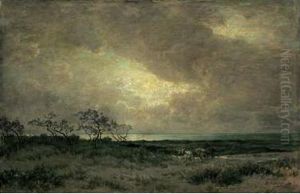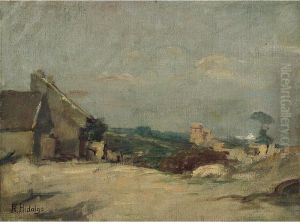Felix Resurreccion Hidalgo Y Padilla Paintings
Felix Resurreccion Hidalgo y Padilla was one of the most celebrated Filipino painters of the late 19th and early 20th centuries, known for his significant contributions to Philippine art and for playing a pivotal role in the Philippine Revolution against Spanish rule. Born on February 21, 1855, in Binondo, Manila, in the Philippines, Hidalgo was born into a wealthy mestizo family with Spanish ancestry. He showed an early interest in art and was encouraged to pursue his passion by his parents. He received his initial art education at the Ateneo Municipal de Manila and later at the Academia de Dibujo y Pintura in Manila, where he was mentored by the Spanish artist Agustin Saez.
In 1879, Hidalgo traveled to Spain to further his studies, enrolling at the Real Academia de Bellas Artes de San Fernando in Madrid. It was during this period that he was exposed to, and greatly influenced by, the works of European masters, which would play a significant role in the development of his artistic style. Hidalgo achieved critical acclaim in Europe, notably for his paintings that depicted the suffering and injustices faced by Filipinos under Spanish rule. His most famous works, 'Las Virgenes Cristianas Expuestas al Populacho' (The Christian Virgins Exposed to the Populace), which won a silver medal at the 1884 Madrid Exposition, and 'La Barca de Aqueronte' (The Boat of Charon), awarded a silver medal at the 1887 Exposition of Fine Arts in Madrid, are considered masterpieces of Philippine art and have been pivotal in raising awareness about Philippine issues in Europe.
Hidalgo's success in Europe was instrumental in fostering a sense of national identity and pride among Filipinos, and his works inspired a generation of Filipino artists and revolutionaries. Despite his long periods of residence in Europe, Hidalgo remained deeply involved in the Philippine struggle for independence. He was a contemporary and friend of Jose Rizal, the national hero of the Philippines, and his art often reflected the social and political issues of his homeland.
Felix Resurreccion Hidalgo died on March 13, 1913, in Barcelona, Spain, but his legacy lives on. He is remembered as one of the Philippines' most prominent and influential artists, whose works continue to inspire and resonate with Filipinos and art lovers around the world. His contributions to Philippine art have been recognized by numerous awards and honors, and his paintings are displayed in museums and collections both in the Philippines and internationally.






